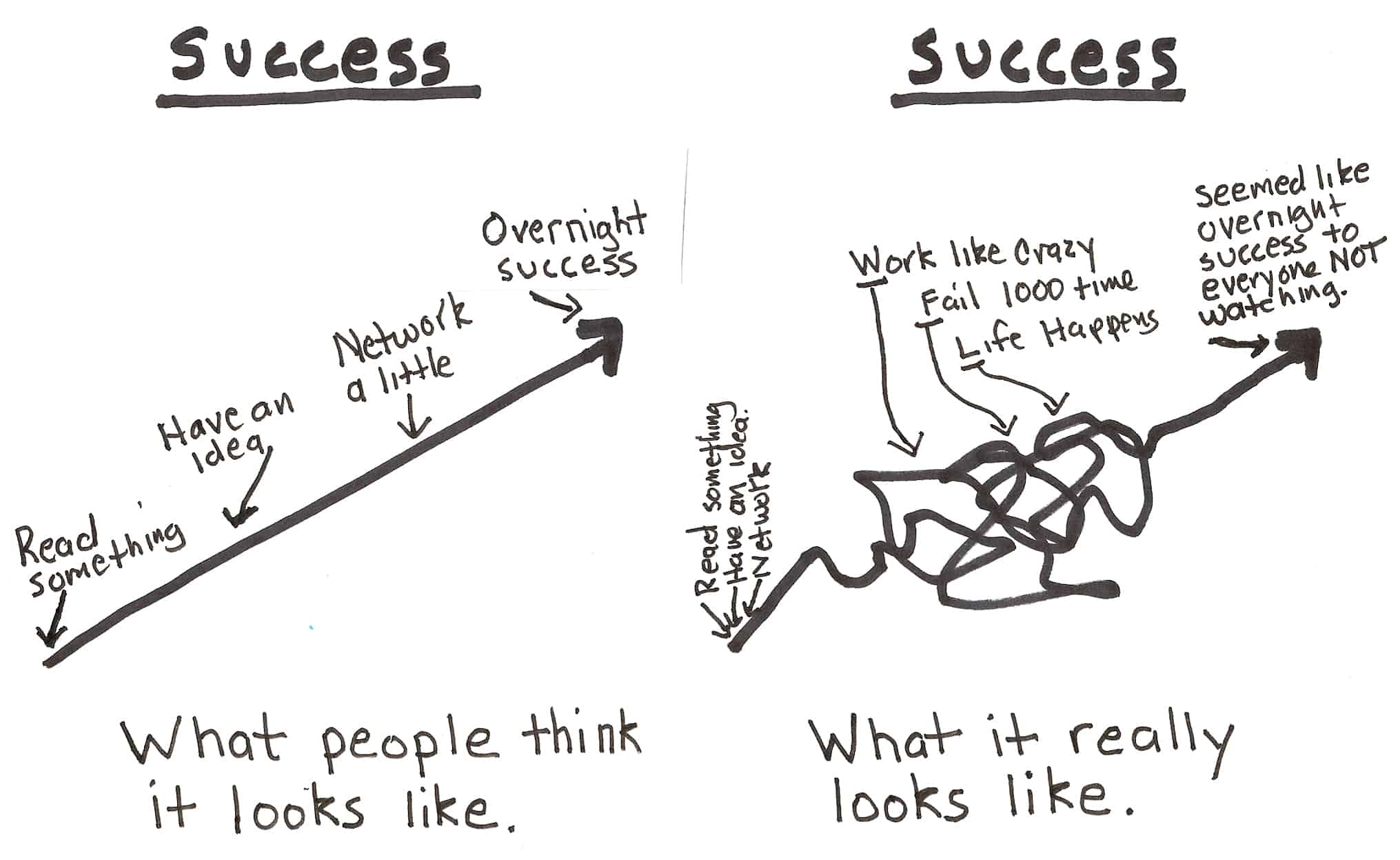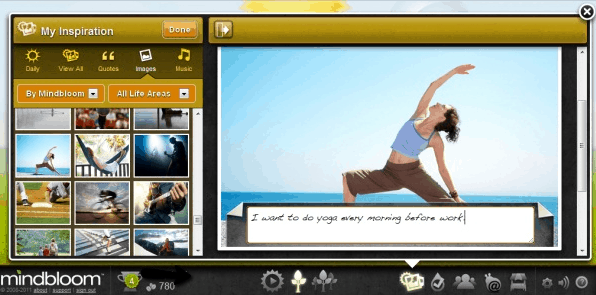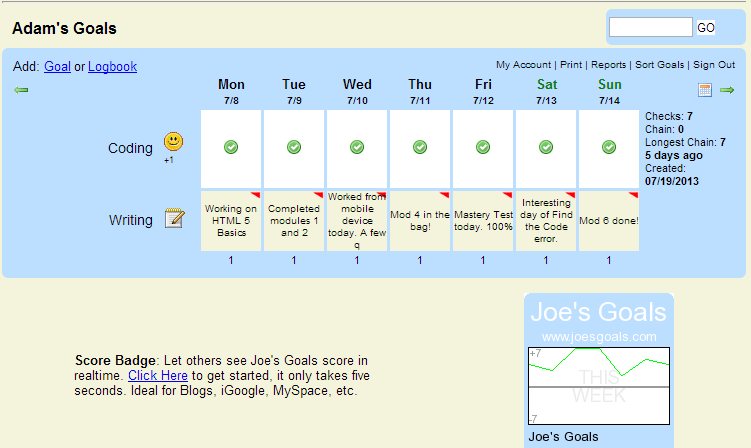GOOOOOAAAAL(s Need to Be Tracked)

Do the “goal setting” people ever get under your skin a little bit? Write your goals down, they said. Work on your goals each day, they said. Track your progress, they said. These goal setters are so annoying that I’ve been keeping a list of their names. Not sure what Gates, Winfrey, Spielberg, Federer, Rowling, and Zuckerberg are up to today, but their advice is like a broken record.
UPDATE
Okay, I’ve had a chance to reevaluate my position after everyone (including the LOL Cats) took the opportunity to point out the flaw in my logic. Maybe Gates et al were on to something. Let’s check it out.
The digital age has brought us some really great goal tracking apps that are great for us personally and professionally and are great for our students both personally and academically. The best of these apps give us data to help us actually analyze our goal pursuits. Before we get to that, though, let’s think about goals for a minute.
Goal For It
Once you start tracking your goals, you’ll soon realize that you’re either getting closer to your goal or the goal is getting further out of reach. Pursuit is not static. Likewise, you must consider that . . . .
Yoda was wrong.
(I know that was shocking!. I should have given some warning.)
Yoda was wrong when he said, “Do or do not. There is no try.”
Well, of course there’s “try.” If you don’t believe me, just ask Thomas Edison. What Yoda meant was, “There is no maintain, just progress or regress.”
Things might work differently on the remote planet that Yoda’s from, but here success looks like this:
Tracking our progress helps us every time we get turned in the opposite directions from our goals, identifying new barriers, and breaking bad habits. Even when you successfully remove all barriers, time can still be a factor. Even if we do not have a deadline, somewhere a clock is ticking. It’s like that extra time in soccer. The end is a mystery. There can be a deadline that we’re not aware of, or we might be approaching the end of our mortal coil. Either way, tic toc tic toc.
You can beat that ticking clock, too. Goal tracking apps are great at messaging you motivational reminders throughout the day. If you have time to surf the internet, watch TV, and play games, then you have time to pursue your goals. Track your goals for about three days. If it’s really important to you, your first habits will start to form.
The best time to plant a tree is twenty years ago. The second best time is today. The same is true for goals. Make this resolution now, though: Don’t make goals part of a New Year’s Resolution. Goals, self improvement, the pursuit of dreams should not be attached to some holiday magic that never pans out. Start your commitment on December 28th or January 9th or May 16, but make it YOUR resolution, not the holiday’s.
The High Achievers
Aristotle taught us that excellence is not act. It is a habit. Goal tracking apps help you break down your goals into chunks so that you can form good habits and break bad habits. This begins the thoughtful process of turning dreams, thoughts, and wishes into actual goals and accomplishments. These apps can help us do a number of things that successful people do all the time:
- Specifically identify goals
- Track your goal progress.
- Track your good and bad habits.
- Encourage you to make regular, small improvements.
- Work outside your comfort zone by monitoring bad habits.
- Target and work on areas of weakness.
Goal Apps
Here are a few of my favorite goal tracking apps:
Mindbloom’s Life Game – Mindbloom (Grow the Life You Want) is mind blowing. It’s loaded with motivational quotes, images, and music that are custom fit for our different areas of life (career, creatively, health, etc.) that play in the background as you track, analyze, and reflect on your goals. You can also upload your own quotes, pics, music. You plant a digital tree at the start and nurture it with the completion of real-life good habits and goal progress. Just don’t let the app get in the way of actually working on your goals. It’s that mesmerizing:
Joe’s Goals – Simple and easy to use. Perfect. Joe’s Goals is just a calendar with check marks (or Xs). A small journal runs below the calendar dates. You can get basic reports, so there’s data to use. This is perfect for establishing good behaviors or extinguishing bad ones.
Habits Pro – This iOS app provides visual data for users. Track with a calendar and journal.
Lift is an iTunes app that really brings in social support. Lift got funding from Twitter cofounders Evan Williams and Biz Stone. Naturally, the app is all about being social. It’s very easy to use, too.
StickK is a web-based app where your put money on the line to give you the incentive to meet your goals. StickK uses “Commitment Contracts to show to yourself and others the value you put on achieving your goals.” If you don’t meet your goal by a certain deadline, the money you wager is donated to a group that you oppose (these are called “anti-charities”). If you eat that $5 hamburger and miss your weekly weight goal, you would lose $50 that would go to a group that you dislike (picture the DNC or RNC). Total cost of hamburger = $55. This app is geared toward adults, and it has led to a lot of success stories. Money and transparency are powerful motivators.
You can find many more goal tracking apps than this, but these are in my curated list. The best apps have an addictive quality that makes you WANT to track your goals, and it turn, you have to DO something to track. Dreaming about your goals can be fun and relaxing. Tracking your goals in real-time can be heart pounding and thrilling.
Students
Parents, teachers, coaches, and mentors can guide students with their goal tracking. Encourage unorganized students to track behaviors and set goals. Let them actually analyze their routine. Understanding and recognizing their weaknesses are essential. If they have self-defeating habits that are sabotaging success, why wouldn’t we want to correct that? They either overcome the bad habits, or the bad habits will define them.
Tracking goals is not one more thing to do. It’s THE thing to do. Most students will not have done a reflective inventory of their habits and behaviors in their entire lives. The goal gurus recommend studying your goals and progress for 15 minutes a day. That’s not working on the goal, that’s studying the work that you’ve done and the work that you need to do.
Students repeat bad habits unconsciously throughout the day, week after week until they are that bad habit. If you think bad habits are difficult to break today, just wait until tomorrow. Good habits do not always come easily. We have to help students nurture good habits like they’re a delicate flower trying to take bloom in the desert. The payoff, though, is absolutely worth all the effort. If you’re not sure where to start with student goal planning, use the SMART approach.
Specific – Goal tracking apps help students identify their goals AND habits in detail. Have students take time to analyze and reflect on their goals. This might be the first time that they’ve ever done that. If a student’s goal is to walk on the rings of Saturn, there might be a few steps in between. Being tardy to school might be because the student left his lunch on the counter at home, so he stopped at McDonald’s on the way to school. The morning tardy issue is actually an afternoon lunch issue.
Measurable – Be sure to help students determine how they can measure their goals. Are they progressing or regressing? This is really where the goal tracking apps are most effective. They collect data which can be used for analysis and reflection.
Attainable – Attainable goals are typically goals that we can control the outcome. Winning the Oscar for screenwriting is in the hands of someone else (the Academy voters). Becoming a solid screenwriter is an attainable goal. You will often hear winners says, “This was never my goal. I often dreamed about it, but it wasn’t my goal.”
Relevant – The goal needs to be something that the student really wants. Students must define their goals. If students are resistant to tracking academic goals, let them start with something very relevant to them and track that. Keep talking to them about academic and classroom success. Eventually start tracking some of those goals, as well. It’s easier to do after they see success in something they care about. “See how good you are at skateboarding after a month of dedicated practice? Doesn’t that sense of accomplishment feel awesome? Wouldn’t it be great if you found the same success in geometry? It’s the same simple process.Want to give it a try?”
Timebound – Having a target date helps with the student’s commitment. Time does not necessarily have to be when a goal is accomplished. It can be a benchmark along the way. It can also be a measure of time that a good habit is repeated or a bad habit is avoided. This can be something like “I practiced French for 30 straight days!” or “I wasn’t tardy once in 30 straight days!”
What’s Next?
How long do habits take to form? Conventional wisdom used to claim that it took 21 days to build solid habits that lead us toward our goals. Unfortunately, that’s a myth. Sort of like the need to drink 8 cups of water a day. Both were numbers that can trace their origins back in the 1960s. Neither had scientific research behind them. [Also, could we pick a weirder decade to get our research numbers for habit formation?] Researchers today put the bar at about 66 days before habits are formed.
It takes some serious commitment to reach 66 days. We can see improvement along the way, though. Outwardly, we can see real improvement in as little as 21 days. Students will not have mastered skateboarding or geometry in 21 days or the first month, but they will have seen significant improvement and will probably be better at it than most of their friends are. Goal tracking apps give us the data and the visuals to stay the course.







0 Comments
Leave a Comment
Your email address will not be published. All fields are required.